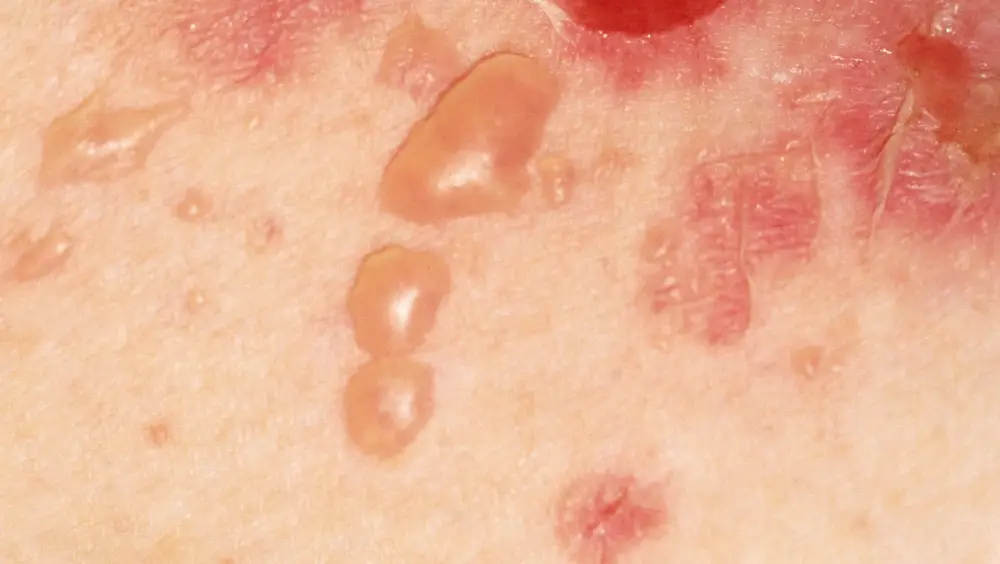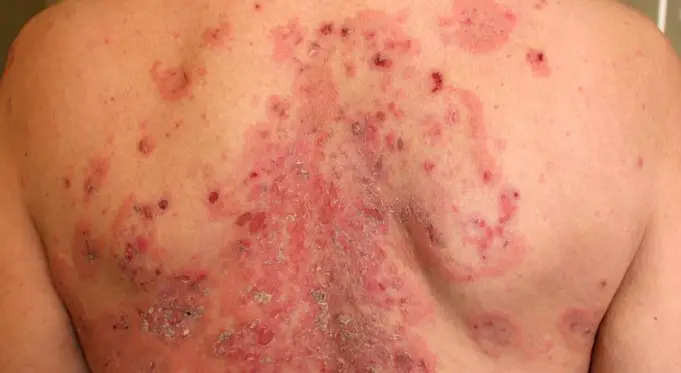Pemphigus can be described as a group of rare autoimmune diseases that causes the blistering of the skin and the production of spores on the skin or the mucous membranes, which are found mostly in the mouth or on the internal part of the genitals.
This rare autoimmune disease causes the skin to break, causing lesions that may sometimes be filled with pus or fluid. The blisters which are formed are usually very soft and easily break open to form sores and injuries.
This condition can occur in healthy people because it is an autoimmune disorder. Often, doctors confuse Pemphigus with other autoimmune skin diseases such as Hailey-Hailey disease, lupus erythematosus, and bullous pemphigoid.
It is important to note that Pemphigus isn’t contagious in nature and can be fully managed with medications. However, if the patient lacks treatment, pemphigoid can lead to the break out of sores on the entire body of the patient and, as such, cause infections.
Pemphigus is a rare disorder. According to research, only about 0.75% is affected by this disease. Also, research shows that only about five people in every 1 million people get to develop this disorder worldwide every year.
Although it is a sporadic disease, however, people who are Jewish, from India, southeast Europe or are from the middle east, are prone to developing this disease faster than everyone else. Children hardly develop this disease; however, people who are within the ashes of 40-60 years of age are more at risk of developing Pemphigus.
It is important to note that Pemphigus cannot be transmitted from mother to child and is not a contagious disease. However, if a close family member of yours has developed Pemphigus, then you may be at a higher risk of developing it.
Causes of Pemphigus
As it was earlier written, Pemphigus is an autoimmune disorder. Usually, your body contains different types of cells, and some of these cells, especially the white blood cells, in turn, produce antibodies.
These antibodies under normal conditions help to fight against foreign harmful substances and prevent them from entering the body. However, in some rare cases, these antibodies can begin to fight against the healthy cells of the patient’s body leading to an autoimmune disorder.
In the case of Pemphigus, these antibodies begin to fight against their healthy skin cells as well as the cells found in the mucous membranes. Most of the time, what triggers the abnormal reactions of these antibodies isn’t known.
However, in some cases, the use of certain drugs have been seen to trigger the abnormal reactions of these antibodies, which in turn, causes Pemphigus. Some of these drugs include penicillin and specific drugs that are used to treat rheumatoid arthritis.
It is important to note that the uncontrolled use of these drugs is what causes Pemphigus and not the drugs itself.
Types of Pemphigus
There are several classes of Pemphigus, and these classes are based on the area where the sores are being formed as well as why the blisters were formed. This classification includes:
Pemphigus Vulgaris
This is the most common type of Pemphigus. Pemphigus Vulgaris majority affects the moist areas of the body, such as internal surfaces of your genitals, your mouth, the lining of your throat, and so on.
Pemphigus Vulgaris usually affects adults, mostly women who are between the ages of 30 to 60 years of age. Although people with pemphigus Vulgaris usually cause blisters in the mouth, it can also cause sores around the body, which often tend to be very slow in healing.
Pemphigus Vegetans
Pemphigus vegetans often have the same physical presentation, such as Pemphigus Vulgaris. However, the difference between these two types of Pemphigus is that while pemphigus Vulgaris produces blisters, pemphigus Vegetans creates wart-like lesions that are often thick in nature.
Pemphigus Endemic
Pemphigus Endemic, also known as endemic Pemphigus or Fogo selvagem, is a rare form of Pemphigus. It mostly affects people in South America, especially Brazil. This form generally affects more than one member of the family.
This means that if a member of your family has developed endemic Pemphigus, there is a higher tendency of another member of the family also to develop the disease.
Paraneoplastic Pemphigus
Paraneoplastic Pemphigus is a very sporadic form of Pemphigus that mostly develops in people that are dealing with cancer.
One of the first symptoms that people with this condition are the formation of blisters in the mouth that mostly takes a lot of time to heal or may not respond to any form of treatment or medication.
Paraneoplastic Pemphigus is often a sure sign that the patient has a tumor brewing somewhere in his or her body. Once this tumor has been extracted, it becomes easy for this blister to heal up and paraneoplastic Pemphigus symptoms to be resolved.
Pemphigus Erythematosus
Another name for pemphigus erythematosus is Senear-Usher Syndrome. This form of Pemphigus causes the development of blisters on the chest, upper back, scalp as well as the cheeks. When these blisters are formed, they often look red and crusty in nature. They often become quite tender and painful to touch.
Drug-Induced Pemphigus
Earlier, we mentioned that there are certain drugs that can cause a patient to develop Pemphigus. This form of Pemphigus is known as the drug-induced Pemphigus. The excessive use of these drugs can cause the formation of blisters.
In some patients, even the mere use of these drugs can cause Pemphigus, and this is because they have developed an allergic reaction to these drugs.
Some of these drugs include penicillin, piroxicam, and so on. In some patients, the blisters may not appear immediately after taking the drugs. For some people, they may start to experience symptoms of Pemphigus six months after using the said drugs.
Pemphigus Foliecus
Pemphigus Foliecus is another form of Pemphigus that is quite common when compared to other forms except for Pemphigus Vulgaris. This form usually begins on the scalp and face, unlike Pemphigus Vulgaris, which begins in the mouth.
Their blisters don’t cause any form of pain; however, they are very itchy in nature. After theme blisters have covered the scalp and face, they may end up proceeding to the chest and the back of the patient.
Symptoms of Pemphigus

If you have Pemphigus, one of the symptoms you would experience is the formation of blisters on the mucous membranes and your skin.
These blisters are tender to touch and can easily rupture when touched. When they rupture, they will form spores that can, in turn, begin to fester, ooze and become infected.
Although these are the typical signs of Pemphigus, however, they have some additional symptoms you may love to pay attention to for those types that are common. They include;












